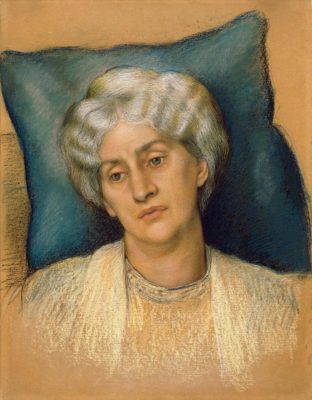On the centenary of her death on 26th January 2014, we take a brief look at the legacy of Jane Morris
“Beauty like hers is genius” – Dante Gabriel Rossetti
Jane Morris (1839-1914) is perhaps as well known for her personal relationships as she is for being the face of many well-known Pre-Raphaelite paintings. Born Jane Burden in Oxford, the daughter of a stableman, she was introduced to Dante Gabriel Rossetti and Edward Burne-Jones at a theatre in 1857. She began to model for these artists, and it was during one of these sittings that she met William Morris, whom she later married. The couple had two daughters, Jenny and May. Her marriage enabled her to gain an education; she became proficient in languages and was a skilled pianist, and transitioned into the upper echelons of society with ease.
Jane shared a deep personal relationship with Rossetti, even after her marriage to Morris, and was an inspiration for many of his artworks. The relationship between Rossetti, Jane and Morris was unconventional and complex; Morris seems to have been aware of their affair, and perhaps even sanctioned it. In 1871 William Morris and Rossetti took out a joint tenancy on Kelmscott Manor. Morris soon left for Iceland, leaving Jane and Rossetti to pursue their relationship.
It is through Rossetti’s copious works that most people are familiar with Jane’s visage.
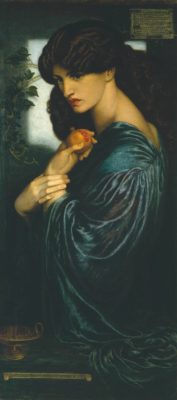
Proserpine 1874 Dante Gabriel Rossetti 1828-1882 Presented by W. Graham Robertson 1940 http://www.tate.org.uk/art/work/N05064
Perhaps you know Jane best as the captive Prosperpine in Rossetti’s brooding painting?
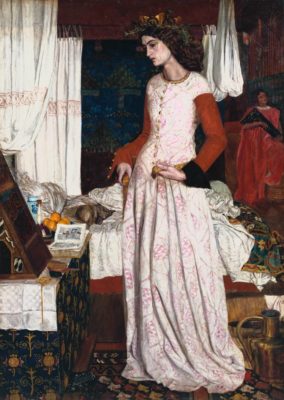
La Belle Iseult 1858 William Morris 1834-1896 Bequeathed by Miss May Morris 1939 http://www.tate.org.uk/art/work/N04999Or maybe as the mourning La Belle Iseult in William Morris’
Or maybe as the mourning La Belle Iseult in William Morris’
only completed easel painting…
Perhaps her name conjures up the moody photographic portraits
taken by John Robert Parsons.
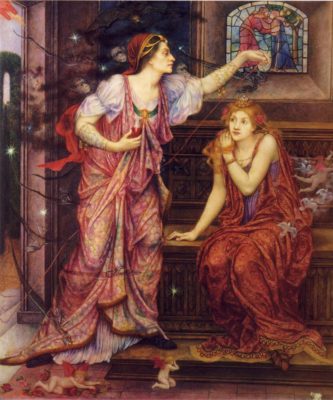 Jane is the model for several of Evelyn De Morgan’s paintings and sketches, as Queen Eleanor poisoning her husband’s mistress in Queen Eleanor and Fair Rosamund, and as an elderly woman contemplating the passing of time and the march towards death in The Hour Glass.
Jane is the model for several of Evelyn De Morgan’s paintings and sketches, as Queen Eleanor poisoning her husband’s mistress in Queen Eleanor and Fair Rosamund, and as an elderly woman contemplating the passing of time and the march towards death in The Hour Glass.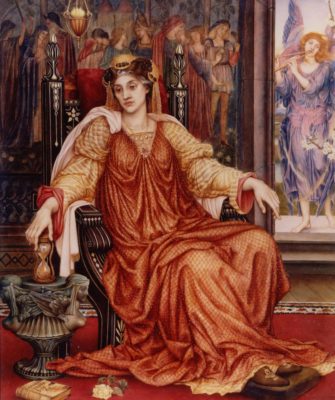
In Evelyn’s pastel study for The Hour Glass. Jane’s advanced age is indicated by her grey hair with its distinctive kinks, quite unlike the flowing brown locks which we normally associate her with.
Though with her strong jawline and heavy hooded eyes, there is no doubt as to the figure’s identity.
Jane seemed somewhat mystified by the fascination she evoked in others, and is quoted as saying ‘Why should there be any special record of me when I have never done any special work?’ But her enduring presence in so many Pre-Raphaelite works of art is testament to the impact Jane made on the people in her life.
We’ve gathered together a selection of portraits of Jane Morris, created using a number of different mediums by various artists; it’s fascinating to see all the different depictions of this familiar face. If you have a favourite Jane Morris portrait, we’d love to hear about it through our Facebook or Twitter.
